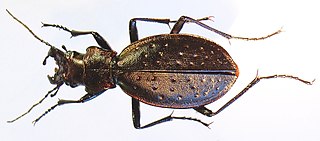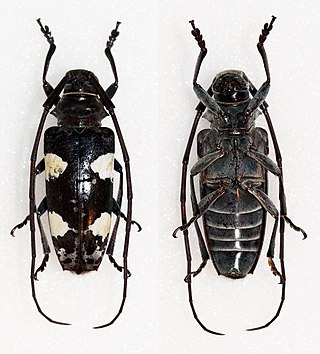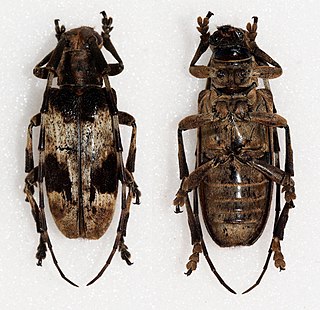
Boiga is a large genus of rear-fanged, mildly venomous snakes, known commonly as cat-eyed snakes or simply cat snakes, in the family Colubridae. Species of the genus Boiga are native to southeast Asia, India, and Australia, but due to their extremely hardy nature and adaptability, have spread to many other suitable habitats around the world. There are 38 recognized species in the genus. According to the study done by Jiří Smíd regarding Old World cat snakes, the ancestor of the cat snake originated in Africa, from where it diversified and expanded to other countries. Despite this diversity however, the different species have very similar needs in terms of temperature and precipitation.

The brown tree snake, also known as the brown catsnake, is an arboreal rear-fanged colubrid snake native to eastern and northern coastal Australia, eastern Indonesia, Papua New Guinea, and many islands in northwestern Melanesia. The snake is slender, in order to facilitate climbing, and can reach up to 2 meters in length. Its coloration may also vary, some being brown, green, or even red. Brown tree snakes prey on many things, ranging from invertebrates to birds, and even some smaller mammals. It is one of the very few colubrids found in Australia, where elapids are more common. Due to an accidental introduction after the events of World War II, this snake is now infamous for being an invasive species responsible for extirpating the majority of the native bird population in Guam. Currently, efforts are being made to reduce and control the population on Guam and prevent the snake from spreading to other locations.

The shipova, scientific name × Pyraria irregularis, synonyms including × Sorbopyrus irregularis, is a hybrid of the European pear and the common whitebeam. It is a small to medium-sized tree growing to 10–18 m tall, with deciduous oval leaves 7–11 cm long and 5–6 cm broad. The fruit is a pome 2.5–3 cm long; it is edible with a sweet, yellowish flesh, which tastes similar to a Nashi pear.

Carabus irregularis is a species of ground beetle endemic to Central Europe, Belgium, Italy, Luxembourg, Ukraine and all states of former Yugoslavia.
Arhythmacanthidae is a family of parasitic worms from the order Echinorhynchida.

Rhizophagus irregularis is an arbuscular mycorrhizal fungus used as a soil inoculant in agriculture and horticulture. Rhizophagus irregularis is also commonly used in scientific studies of the effects of arbuscular mycorrhizal fungi on plant and soil improvement. Until 2001, the species was known and widely marketed as Glomus intraradices, but molecular analysis of ribosomal DNA led to the reclassification of all arbuscular fungi from Zygomycota phylum to the Glomeromycota phylum.

Blepephaeus is a genus of longhorn beetles of the subfamily Lamiinae, containing the following species:
Blepephaeus andamanicus is a species of beetle in the family Cerambycidae. It was described by Stephan von Breuning in 1935. It is known from the Andaman Islands.
Blepephaeus indicus is a species of beetle in the family Cerambycidae. It was described by Stephan von Breuning in 1935. It is known from India.
Blepephaeus lemoulti is a species of beetle in the family Cerambycidae. It was described by Stephan von Breuning in 1938. It is known from Laos.
Blepephaeus strandi is a species of beetle in the family Cerambycidae. It was described by Stephan von Breuning in 1936.
Blepephaeus fulvus is a species of beetle in the family Cerambycidae. It was described by Maurice Pic in 1933. It is known from Malaysia, China, Vietnam, and Thailand.
Blepephaeus higaononi is a species of beetle in the family Cerambycidae. It was described by Vives in 2009. It is known from the Philippines.
Blepephaeus infelix is a species of beetle in the family Cerambycidae. It was described by Francis Polkinghorne Pascoe in 1856. It is known from China and North Korea.
Blepephaeus nepalensis is a species of beetle in the family Cerambycidae. It was described by Masao Hayashi in 1981. It is known from Nepal.
Blepephaeus puae is a species of beetle in the family Cerambycidae. It was described by Lin in 2011. It is known from China.
Blepephaeus stigmosus is a species of beetle in the family Cerambycidae. It was described by Charles Joseph Gahan in 1895. It is known from Malaysia, Laos, and Myanmar. It contains the varietas Blepephaeus stigmosus var. laosensis.
Blepephaeus subcruciatus is a species of beetle in the family Cerambycidae. It was described by White in 1858.

Blepephaeus succinctor is a species of beetle in the family Cerambycidae. It was described by Louis Alexandre Auguste Chevrolat in 1852, originally under the genus Monohammus. It is known from Malaysia, India, Sumatra, Myanmar, Taiwan, China, Thailand, and Vietnam. It feeds on Acacia confusa, Albizia chinensis, Firmiana simplex, Melia azedarach, Morus alba, and Vernicia fordii.
Blepephaeus undulatus is a species of beetle in the family Cerambycidae. It was described by Maurice Pic in 1930.







